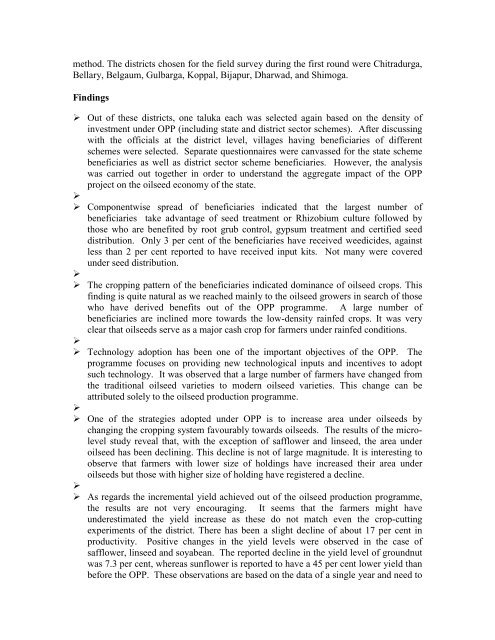Oilseeds Production Programme (OPP)
Oilseeds Production Programme (OPP)
Oilseeds Production Programme (OPP)
You also want an ePaper? Increase the reach of your titles
YUMPU automatically turns print PDFs into web optimized ePapers that Google loves.
method. The districts chosen for the field survey during the first round were Chitradurga,<br />
Bellary, Belgaum, Gulbarga, Koppal, Bijapur, Dharwad, and Shimoga.<br />
Findings<br />
Out of these districts, one taluka each was selected again based on the density of<br />
investment under <strong>OPP</strong> (including state and district sector schemes). After discussing<br />
with the officials at the district level, villages having beneficiaries of different<br />
schemes were selected. Separate questionnaires were canvassed for the state scheme<br />
beneficiaries as well as district sector scheme beneficiaries. However, the analysis<br />
was carried out together in order to understand the aggregate impact of the <strong>OPP</strong><br />
project on the oilseed economy of the state.<br />
<br />
Componentwise spread of beneficiaries indicated that the largest number of<br />
beneficiaries take advantage of seed treatment or Rhizobium culture followed by<br />
those who are benefited by root grub control, gypsum treatment and certified seed<br />
distribution. Only 3 per cent of the beneficiaries have received weedicides, against<br />
less than 2 per cent reported to have received input kits. Not many were covered<br />
under seed distribution.<br />
<br />
The cropping pattern of the beneficiaries indicated dominance of oilseed crops. This<br />
finding is quite natural as we reached mainly to the oilseed growers in search of those<br />
who have derived benefits out of the <strong>OPP</strong> programme. A large number of<br />
beneficiaries are inclined more towards the low-density rainfed crops. It was very<br />
clear that oilseeds serve as a major cash crop for farmers under rainfed conditions.<br />
<br />
Technology adoption has been one of the important objectives of the <strong>OPP</strong>. The<br />
programme focuses on providing new technological inputs and incentives to adopt<br />
such technology. It was observed that a large number of farmers have changed from<br />
the traditional oilseed varieties to modern oilseed varieties. This change can be<br />
attributed solely to the oilseed production programme.<br />
<br />
One of the strategies adopted under <strong>OPP</strong> is to increase area under oilseeds by<br />
changing the cropping system favourably towards oilseeds. The results of the microlevel<br />
study reveal that, with the exception of safflower and linseed, the area under<br />
oilseed has been declining. This decline is not of large magnitude. It is interesting to<br />
observe that farmers with lower size of holdings have increased their area under<br />
oilseeds but those with higher size of holding have registered a decline.<br />
<br />
As regards the incremental yield achieved out of the oilseed production programme,<br />
the results are not very encouraging. It seems that the farmers might have<br />
underestimated the yield increase as these do not match even the crop-cutting<br />
experiments of the district. There has been a slight decline of about 17 per cent in<br />
productivity. Positive changes in the yield levels were observed in the case of<br />
safflower, linseed and soyabean. The reported decline in the yield level of groundnut<br />
was 7.3 per cent, whereas sunflower is reported to have a 45 per cent lower yield than<br />
before the <strong>OPP</strong>. These observations are based on the data of a single year and need to
















